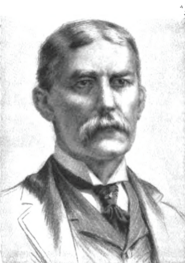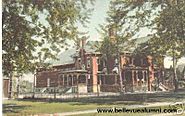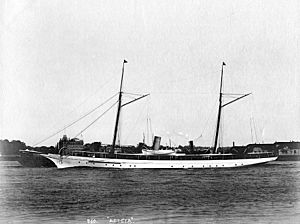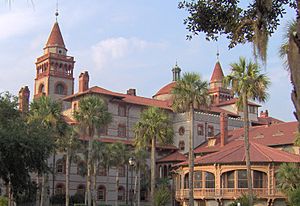Henry Flagler facts for kids
Quick facts for kids
Henry Morrison Flagler
|
|
|---|---|
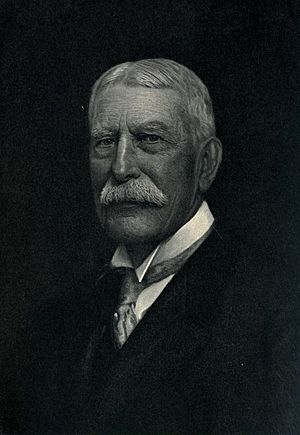
Portrait of Henry Flagler
|
|
| Born |
Henry Morrison Flagler
January 2, 1830 Hopewell, New York, U.S.
|
| Died | May 20, 1913 (aged 83) Palm Beach, Florida, U.S.
|
| Resting place | Memorial Presbyterian Church, St. Augustine, Florida, U.S. |
| Net worth | USD $60 million at the time of his death (about 1/651st of U.S. GNP) |
| Children | Jennie Louise (March 18, 1855 – March 25, 1889) Carrie Harkness Flagler (1858–1861) Harry Harkness Flagler (1870–1952) |
Henry Morrison Flagler (January 2, 1830 – May 20, 1913) was an important American businessman. He helped start Standard Oil, a huge oil company. He also played a big part in building up the Atlantic coast of Florida. He founded the Florida East Coast Railway and is known as the "father" of Miami and Palm Beach, Florida.
Contents
Henry Flagler's Early Life and First Business
Henry Flagler was born in Hopewell, New York. His father was a Presbyterian minister. When Henry was 14, he moved to Ohio to work with his half-brother, Daniel Harkness, in a store. He earned $5 a month plus a place to live and food. By 1849, he was earning $40 a month.
Later, Henry and his brother-in-law started the Flagler and York Salt Company in Michigan. This business struggled during the American Civil War and eventually failed. Flagler lost a lot of money. He learned a valuable lesson: always research a business carefully before investing.
Building the Standard Oil Company
After his salt business failed, Flagler returned to Ohio in 1866. He went back into the grain business. Here, he met John D. Rockefeller, who was starting an oil refining business.
In 1867, Rockefeller needed money for his new company. Flagler's stepbrother, Stephen V. Harkness, invested $100,000. Flagler became a partner in the new company, Rockefeller, Andrews & Flagler. This company later became the huge Standard Oil Corporation.
It was Flagler's idea to use a system of discounts, called rebates, to help Standard Oil grow. They got big discounts on shipping oil. This helped them sell oil for less than other companies. By 1872, Standard Oil was a leader in the American oil refining industry.
Standard Oil's Growth and Challenges
Standard Oil grew very fast. They bought out many smaller oil refineries. In just four months in 1872, they bought 22 of 26 competing companies in Cleveland. Flagler and Rockefeller believed they were making the oil industry stronger and more efficient.
Standard Oil also built its own pipelines, tank cars, and delivery networks. They kept oil prices low so more people could afford their products. They even developed over 300 oil-based products, from tar to Vaseline. By the late 1870s, Standard Oil refined over 90% of the oil in the U.S.
In 1877, Standard Oil had a big disagreement with the Pennsylvania Railroad. Flagler and Rockefeller wanted to use pipelines to transport oil. The railroad fought back by trying to buy oil refineries themselves. Standard Oil stopped shipping oil with them, starting a price war. Flagler and Rockefeller won, and the railroad sold its oil businesses to Standard Oil.
Becoming a Monopoly
Standard Oil slowly gained almost complete control of oil refining in the United States. They delivered kerosene directly to customers, bypassing other sellers. Even though they made kerosene cheaper and better, their business methods caused problems. They were criticized for their monopolistic ways, which means they had too much control over the market.
In 1882, Flagler and Rockefeller created the Standard Oil Trust. This was a new way to combine many companies under one management. It made their company even bigger and wealthier. The public and the press were suspicious of this new powerful group.
By the 1880s, Standard Oil was incredibly powerful. It had 20,000 oil wells, 4,000 miles of pipeline, and over 100,000 employees. They refined over 90% of the world's oil at one point.
However, new oil discoveries in other countries and the invention of the light bulb (which reduced the need for kerosene) slowly lessened their control. Standard Oil adapted by expanding into natural gas and then gasoline for cars.
In 1890, the Sherman Antitrust Act was passed to control large companies like Standard Oil. In 1911, the Supreme Court of the United States ruled that Standard Oil was an illegal monopoly. It was ordered to break up into 34 new, smaller companies. Many of these companies are still well-known today, like Conoco, BP, Chevron, and ExxonMobil.
Flagler's Impact on Standard Oil
Henry Flagler was a key person in the success of Standard Oil. He and Rockefeller worked very hard. Rockefeller himself said that Flagler was the "brains" behind the booming oil refining business. Flagler was actively involved in Standard Oil until 1882. He remained a vice president until 1908 and an owner until 1911.
Developing Florida: Hotels and Railroads
Flagler first visited Florida when his first wife, Mary, was sick. Her doctor suggested they go to Jacksonville for the warm winter. Flagler loved the sunny weather.
After Mary died in 1881, Flagler married Ida Alice. They visited Saint Augustine. Flagler found the city charming, but he thought the hotels and transportation were not good enough. This gave him an idea for Florida's future.
Even though he was still on the board of Standard Oil, Flagler focused on his new interests in Florida. In 1885, he started building the huge 540-room Ponce de Leon Hotel in St. Augustine. It opened in 1888 and was a big success. This hotel is now part of Flagler College.
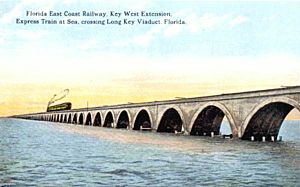
Flagler realized he needed good transportation for his hotels. So, he bought several small railroads and combined them to create the Florida East Coast Railway. He used a system of forced labor, where people had to work without pay, to build and improve the railroads. This system was very unfair and was later investigated.
Flagler wanted to create a new "American Riviera" in Florida. He built a railroad bridge across the St. Johns River to reach the southern part of the state. He also bought and built more hotels, like the Hotel Ormond and the Alcazar Hotel (now the Lightner Museum).
Building Palm Beach and Miami
Flagler worked hard to extend his railroad through the wilderness to Palm Beach. By 1894, he completed the 1,100-room Royal Poinciana Hotel in Palm Beach. He also extended his railroad to West Palm Beach, founding both cities. The Royal Poinciana Hotel was the largest wooden building in the world at that time.
In 1894 and 1895, severe freezes hit Florida. The area that is now Miami was not harmed. Landowners like Julia Tuttle and William Brickell offered Flagler land if he would extend his railroad to Miami.
This led to the development of Miami. Flagler encouraged farming and settlement along his railway. He also helped build hospitals, churches, and schools in Florida.
By 1896, Flagler's railroad reached Biscayne Bay. Flagler helped build streets, water systems, and power systems in Miami. He also financed the city's first newspaper. When the city was officially formed in 1896, citizens wanted to name it "Flagler." He refused, suggesting they use the old Indian name, "Mayaimi" (Miami). Instead, an artificial island called Flagler Monument Island was built in his honor. In 1897, he opened the Royal Palm Hotel in Miami. He became known as the "Father of Miami, Florida."
In 1901, Flagler's second wife, Ida Alice, became ill. He later married Mary Lily Kenan. As a wedding gift to Mary Lily, he built Whitehall in Palm Beach in 1902. This huge 55-room home is now the Flagler Museum.
In 1905, Flagler decided to extend his railroad even further, all the way to Key West. Key West was Florida's largest city and close to the Panama Canal, which the U.S. government planned to build. Flagler wanted to benefit from trade with Cuba and Latin America.
In 1912, the Overseas Railroad was completed to Key West. Over 30 years, Flagler invested about $50 million in Florida's railroads, homes, and hotels.
Death and Legacy

In March 1913, Henry Flagler fell down some stairs at his home, Whitehall. He never recovered and died on May 20, 1913, at the age of 83. On the day of his funeral, every train on the Florida East Coast Railway stopped for ten minutes as a tribute to him.
Flagler was buried in the Flagler family tomb in Memorial Presbyterian Church in St. Augustine.
Many places in Florida are named after Henry Flagler. Flagler Street is a main street in Miami. There is a monument to him on Flagler Monument Island in Miami. Flagler College and Flagler Hospital in St. Augustine are named after him. Flagler County, Florida, Flagler Beach, Florida, and even Flagler, Colorado, also carry his name. His home, Whitehall, is now the Henry Morrison Flagler Museum, where his private railcar is preserved.
In 2006, statues of Flagler were unveiled in Key West and Miami to honor his contributions.
The Overseas Railroad was badly damaged by a hurricane in 1935. The railroad could not afford to rebuild it. The state of Florida bought the railway's path and bridges and used them to build the Overseas Highway to Key West.
Flagler's third wife, Mary Lily Kenan Flagler Bingham, was a generous supporter of the University of North Carolina at Chapel Hill. The top-ranked Kenan-Flagler Business School there is named for Flagler and his wife.
Images for kids
-
Florida East Coast Railway (FECR), Key West Extension, express train at sea, crossing Long Key Viaduct, Florida.
-
Statue of Henry Flagler in front of Flagler College in Saint Augustine, Florida.
See also
 In Spanish: Henry Morrison Flagler para niños
In Spanish: Henry Morrison Flagler para niños


